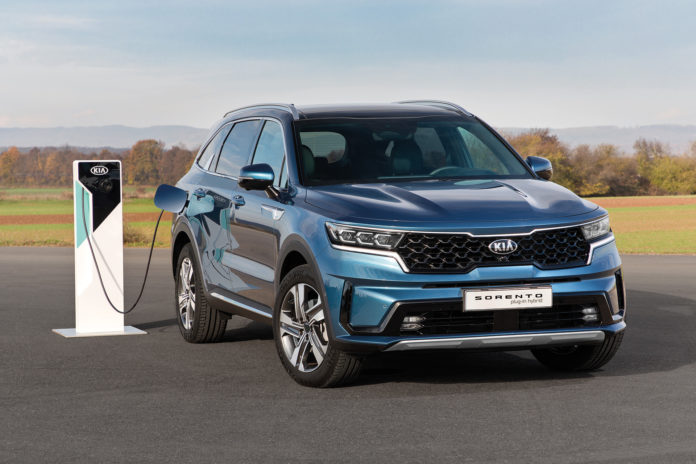
Kia Motors have revealed the all-electric range and CO2 emissions data for the new Kia Sorento Plug-in Hybrid as the model enters production in Korea.
The full-size, seven-seat SUV will deliver an equivalent all-electric range (EAER) of up to 57 kilometres (WLTP*) from a single charge of its 13.8 kWh battery pack. Furthermore, in urban environments it is capable of travelling up to 70 kilometres on a single charge (EAER city) before its turbocharged gasoline engine starts up.
Drivers are therefore able to complete many journeys, such as their daily commute, on zero-emissions electric power alone.
Its plug-in hybrid powertrain also promises the lowest CO2 emissions ever offered by the Kia Sorento. With emissions of just 38 g/km (WLTP, weighted combined**), the new model is one of the most efficient vehicles in its class.
Furthermore, Kia Sorento PHEV customers will be eligible to access the brand’s new KiaCharge service. This provides access to a pan-European integrated public charging network of around 160,000 charge points via a single card and app.
KiaCharge offers attractive charging tariffs to EV and PHEV owners based on their individual charging needs, with a single monthly invoice and no need for multiple vehicle charging accounts or subscriptions.
Strong performance, emissions-free travel
The Kia Sorento Plug-in Hybrid features a powerful 1.6-litre T-GDi (turbocharged gasoline direct injection) engine, which on its own produces 180 ps and 265 Nm of torque.
Combined with an electric motor producing 67 kW and 304 Nm of torque, the Sorento Plug-in Hybrid delivers a combined 265 ps and 350 Nm of torque, making it the most powerful Sorento ever sold in Europe.
The engine and motor are paired with a high-capacity 13.8 kWh lithium-ion polymer battery, enabling the Sorento Plug-in Hybrid’s substantial all-electric range.
For longer journeys, the powertrain combines electric and combustion engine power. Drive is sent to the front wheels or all four wheels, depending on road conditions, via a quick-shifting six-speed automatic transmission.
Easy to use, intelligently packaged
Drivers can keep track of the powertrain’s status via the 12.3-inch fully-digital instrument cluster. This enables them to check the battery’s state of charge and monitor the flow of electric and gasoline power through the powertrain.
Drivers can also easily locate nearby charging points on-the-go via the 10.25-inch touchscreen infotainment system, powered by Kia’s innovative UVO Connect ‘connected car’ system.
The Kia Sorento Plug-in Hybrid’s powertrain has been intelligently packaged to ensure it offers the maximum possible cargo capacity and cabin space for up to seven occupants.
The electric motor is mounted between the engine and transmission, enabled by the neat packaging of the downsized turbocharged engine beneath the bonnet.
The Sorento’s battery pack is been positioned beneath the driver and front passenger seats. In the Sorento’s all-wheel drive configuration, the ‘saddle-shaped’ battery pack lays over the top of the propshaft.
The Sorento PHEV’s 67-litre fuel tank is located beneath the floor underneath the second row of seats, while the 3.3 kW on-board charger is situated beneath the cargo floor.
The location of these components means all passengers – including those in the third row of seats – still enjoy plenty of legroom and a comfortable seating position.
This layout also means the battery pack doesn’t intrude on the Sorento’s cabin or cargo space in the same way that it might in many other plug-in hybrid models, where the battery often takes up valuable boot space.
Production begins, with first European sales in early 2021
The new Kia Sorento Plug-in Hybrid has started production this week at Kia’s Hwasung manufacturing facility in Korea. It will go on-sale across Europe in early 2021, with all models covered by Kia’s 7-year, 150,000-kilometre warranty. The warranty also covers the car’s electric motor and battery pack.
* WLTP: Worldwide Harmonised Light Vehicle Test Procedure
** ‘weighted combined’ emissions are a weighted average of the Sorento’s CO2 emissions in ‘charge-depleting’ (12.5 g/km) and ‘charge-sustaining’ (172 g/km) driving conditions








